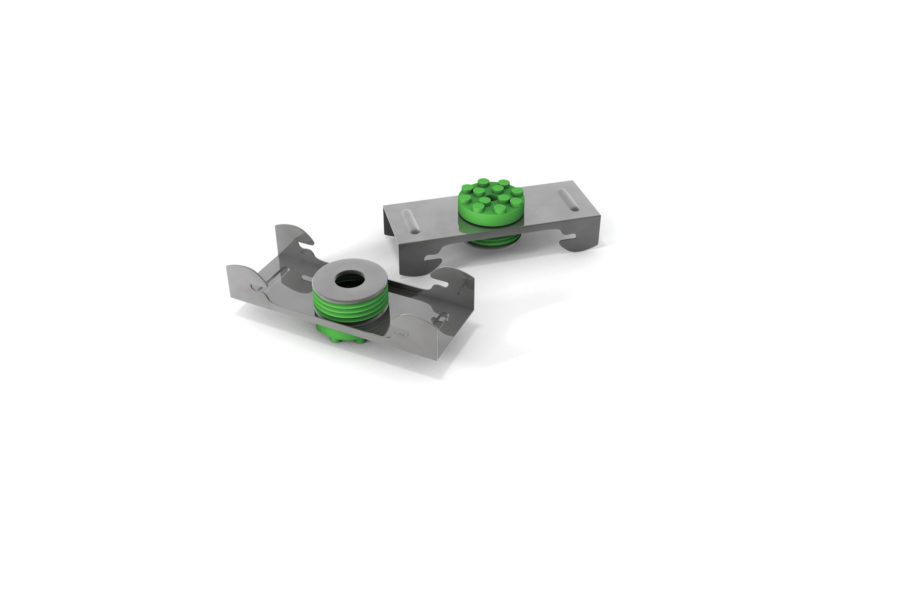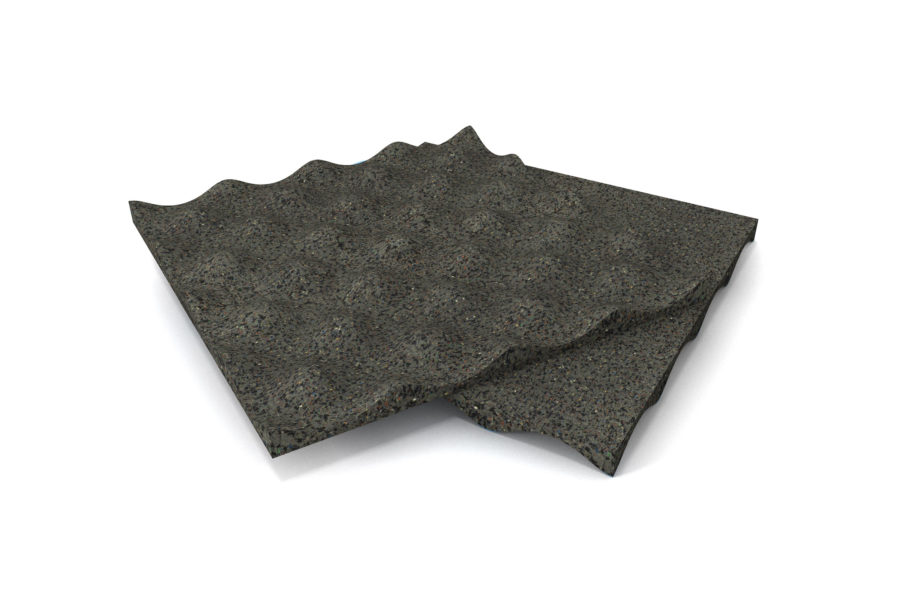Story at a glance:
- The experts share how an important flexible material keeps buildings and bodies young.
- REGUPOL products ensure building longevity, human vitality, and environmental health.
- REGUPOL products align with LEED and WELL building certification imperatives.
There is an old saying about putting someone inside a plastic bubble, a rubber room, or a Teflon suit to protect their well-being. Besides being highly unfeasible for those going about their lives in a modern world, we know plastics and Teflon are detrimental chemicals. That said, when SBR crumb rubber (post-consumer tires diverted from landfills) is processed, manufactured, and repurposed properly, these materials deployed in building design and construction can contribute to positive human and ecological health outcomes.
Sheltered and At-Risk
For 90% of our lives or more (especially if you consider those winter months of sheltering in place), the buildings that protect us from the elements also leave us vulnerable to health risks. Environmental exposures, sometimes referred to as the “exposome,” have an extremely powerful effect on short- and long-term health outcomes.
Those in the industry who go beyond the code to improve health indoors turn to products that comply with LEED and the WELL Building Certification’s standard of care to enhance human healthspan—or the years of life we remain healthy—quality of life, and longevity.
Building Health and Beauty Sleep
If we thought about building products like we think about the supplements, beauty products, and personal trainers we employ to keep us young, we’d be using REGUPOL acoustic solutions from head to toe and beyond. Acoustic products support so many facets of human thriving and ecological health in the built environment. Especially those aspects underscored by LEED and the WELL Building Standard.
One way I like to think of LEED and WELL Building Standards is in terms of how they support sleep. If you’ve studied them, you’ll notice many of the WELL and LEED imperatives orbit around healthy sleep hygiene. And if you’ve studied sleep, you know this is because sleep is the number one predictor of short- and long-term health outcomes—both physical and mental health outcomes. Getting your beauty sleep is not just an exercise in vanity.
Acoustics play a significant role in the quality and quantity of sleep we get. Good acoustics in a building—meaning sound is contained to the room where it occurs as opposed to transmitting through walls, floors, and ceilings to adjacent living space—mean sleep is less interrupted and more comfortable.
Noise Pollution No More

REGUPOL SonusClip. Image courtesy of REGUPOL
Acoustics is the leading cause of dissatisfaction in commercial buildings. How is acoustics related to longevity? Acoustic discomfort is related to higher stress and cortisol levels that result in chronic inflammation and inflammatory pulmonary diseases like heart attack and stroke. In fact, noise pollution is second only to air pollution as the number two cause of death, according to the World Health Organization.
Using REGUPOL SonusClip drywall clips meets the WELL Building Standard’s Comfort preconditions to mitigate exterior noise intrusion and internally generated noise. A robust wall construction stops structure-borne noise, and excellent building acoustic values can be achieved with these easy-to-install rubber and metal fasteners—even where little wall mass is available, like in a multi-family high-rise. The LEED equivalent to this WELL feature is IEQ (Indoor Environmental Quality).
Nervous System Reset

REGUPOL curve. Image courtesy of REGUPOL
Following through with healthy noise mitigation and IEQ also supports WELL’s healthy sleep policy. This policy requires a well-considered building design and construction to support the actual act of sleeping. Incessant building vibrations due to mechanical systems or nearby transportation infrastructure cause constant disharmony in the brain and body, which make it exceedingly difficult for the nervous system to relax into sleep.
Using cost-effective REGUPOL sonus curve dimpled flooring underlayment reduces the transmission of impact sound generated by footfall noise. Specifying this type of sound isolation material in the floor-to-ceiling assembly helps guarantee complete serenity and sleep that supports a nervous system reset even in multi-family and mixed-use buildings.
Reuse and Renovation
Faced with a housing shortage and the added expense of urban infill projects, developers are transforming abandoned mills in gateway cities into high-end loft residences. This nationwide multi-family trend looks to satellite suburbs across the rustbelt and sunbelt regions and presents a low-carbon alternative to building on greenfields.
These old sturdy mill structures, some up to 200 years old, were once staples of early American manufacturing. Their large spans make them ideal for consumers seeking high ceilings, open floor plans, and industrial chic looks. But practical considerations for a successful multi-family development reach far beyond aesthetics. Factors like energy efficiency and acoustic remediation require extreme attention and expertise to ready mill buildings for new life.
Old factory floors, windows, and walls require a number of considerations to meet acoustical comfort levels that suit the expectations for sound separations in high-end multi-family housing. Old floors with thick, chestnut planks that are 10- to 12-inches wide and very long are striking and rich in history. But acoustic bridging through this old flooring presents a major concern. In some cases cracks between the plank flooring lead directly into the unit below.
The renovation of the historic Water Street Mill complex in Williamstown, Massachusetts included converted restoration of the since-abandoned properties into a revitalized mix of lofts, apartments, and condominiums. Finegold Alexander Architects designed the interiors of 61 housing units—13 of them designated affordable. The directive for all of them was to utilize highly sustainable, energy-efficient, and eco-friendly systems and materials. They specified REGUPOL sonus curve—a cost-effective, dimpled flooring underlayment made from recycled tire rubber to provide the best acoustic experience for all Cable Mills residents.
Exercise Stokes Connection
The fitness category of WELL supports healthy sleep hygiene with regular daily movement and the cognitive longevity associated with vigorous exercise and muscle-building involved in cross-training, weightlifting, and HIIT (high intensity interval training). REGUPOL sports flooring is specially designed to absorb impact and vibrations associated with indoor sports, including heavy equipment like recumbent fitness and weightlifting machines.
Maintaining quality of life and longevity in close proximity to living, working, and leisure activities relies critically on ensuring green and open spaces are woven into the urban civic life.
Due to lack of space, the Bellevue di Monaco project used REGUPOL rooftop underlayment to take advantage of its rooftop as a “fifth facade,” where a new rooftop pitch (soccer field) takes advantage of the views above the increasingly dense city of Munich. Whether you play or watch, sports connect people with shared experiences. Team sports create identity, belonging, participation, and values critical to community connection, individual health, and resilience.
Lighting Matters
Mitigating interior and exterior building acoustics with REGUPOL rooftop and building foundation recycled foam products also affords buildings a larger window-to wall ratio, letting in more daylight and views to nature, which support biophilia and circadian lighting design—preconditions of WELL’s mind and light categories respectively. Circadian lighting is yet another pillar that upholds healthy sleep cycles.
121 E. Route 66
Many developments position themselves nearby to transit hubs to attract residents with ready access to public transportation. However, this creates a challenge for the developer and owner to ensure they design and deliver high-level acoustics needed to keep residents shielded from noise and vibration caused by this mobility amenity.
At 121 E. Route 66—a 198-unit mixed-use development in Glendora, California—the construction uses high-performance floating floor vibration isolation products to neutralize primary noise sources while allowing for a thinner slab. The high-performance floating floor shields residents from noise pollution in the form of vehicle traffic and the adjacent freight railroad, and future-proofs the building to ensure residents are protected from additional noise pollution associated with the proposed extension of the Metro Gold Line.
Breathe Easy
None of the physical activity, piece of mind, or healthy sleep mentioned above could be considered worthwhile without protecting the respiratory system. REGUPOL rubber underlayment meets the rigorous air and IEQ requirements of both WELL and LEED. Its products are extremely low-emitting materials that support respiratory health and indoor air quality. REGUPOL’s EPDs, HPDs, and Green Circle Certification verify it is in alignment with the material transparency encouraged in both the WELL and LEED rating systems.
REGUPOL building foundation underlayment and recycled foam rooftop products also contribute to pristine IAQ by meeting the moisture management requirements in WELL’s air category to prevent water intrusion and the growth of mold, mildew, and other water-borne bacteria that could trigger respiratory distress, inflammatory conditions, and allergic reactions.
The Circular Economy OG
One final behind-the-scenes but important fact we care about when it comes to our food, health, and beauty products is how they’re made and if it’s ethical. Applied to a building product, that might look like recycling or the circular economy. REGUPOL was one of the original manufacturers to implement upcycling in its product lines by reclaiming post-consumer tires. In fact, REGUPOL is one of the largest consumers of post-industrial polymers in the world. The company’s products use 93 to 96% post-consumer waste, diverting that from landfills to recycle 99M tons of elastomers per year and helping to support the ecological health of our planet and the water table.
What’s more, its water and energy-efficient manufacturing processes conserve valuable natural resources, which satisfies LEED’s sustainable building material imperative.
From head to toe, rooftop to door jamb, REGUPOL products contribute to LEED and WELL certifications but more importantly, they ensure building longevity, human vitality , and environmental health.


